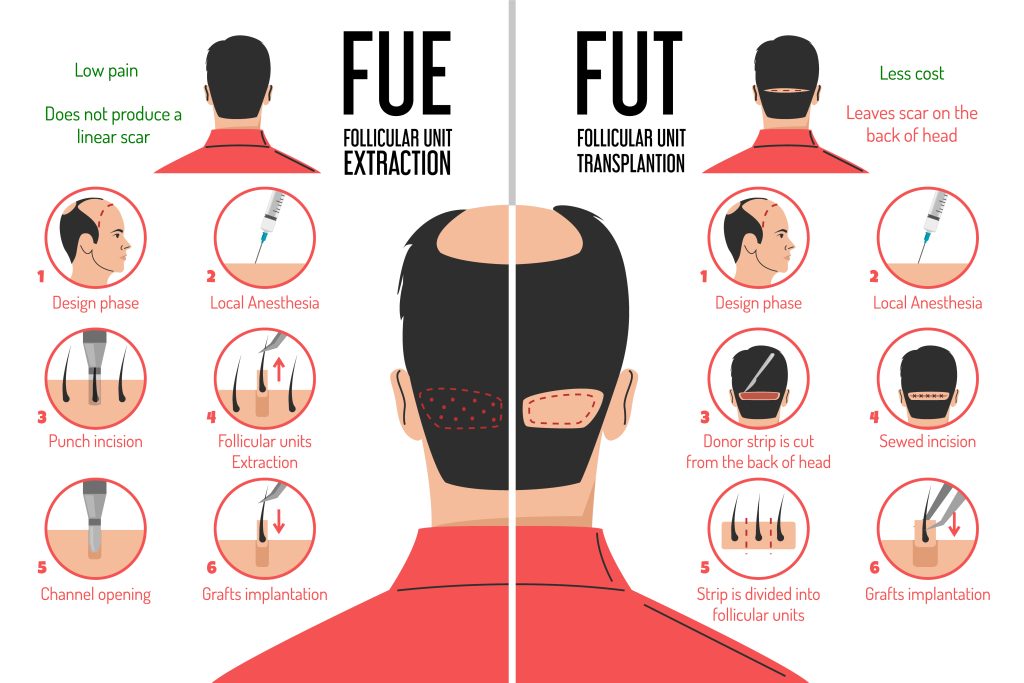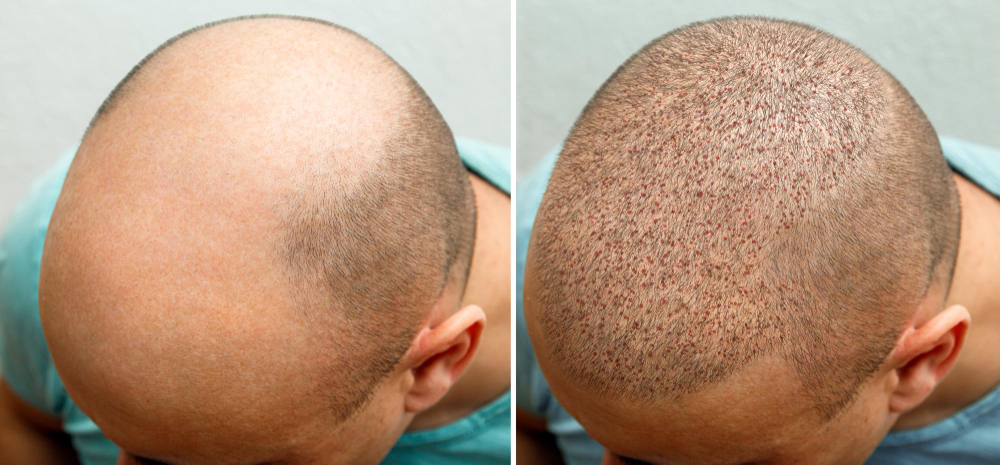Who can have a hair transplant?
Hair transplantation is appropriate for individuals with hereditary, irreversible hair loss.
Typically, individuals experiencing hair loss characterized by bald spots (alopecia areata) are not good candidates for this treatment method.

What Is a Hair Transplant?
This is a surgical procedure that relocates existing hair to a region of the scalp with little to no hair. The practice of transplanting hair has been carried out by medical professionals in the United States for several decades, but the methodologies used have evolved significantly in recent times.
Normally, the process takes place in the medical practitioner’s clinic. Initially, the surgeon sterilizes your head and administers an anesthetic to numb the back of your head. Your physician will determine which method to use for the transplant, either follicular unit strip surgery (FUSS) or follicular unit extraction (FUE).
By using FUSS, the doctor takes out a portion of skin, about 6-10 inches in length, from the posterior part of your head. This part is then put aside while the scalp is sewn shut. As a result, the area is in close proximity to the hair surrounding it, making it invisible.
Which individuals are suitable for a hair transplant?
People of every ethnicity and gender are suitable contenders for a hair transplant procedure.
In order to be eligible for a hair transplant, there are two requirements that must be met:
- A sufficient amount of hair that is healthy and can be moved from one area of the scalp to another where there is a need for hair.
- The capacity to generate hair on the portion of your head that is experiencing hair loss.
By consulting with a dermatologist, you can determine if you possess both conditions. The dermatologist will perform a comprehensive examination of your scalp.
What a hair transplant involves?
Generally, local anesthesia and sedation are administered during a hair transplant procedure which implies that even though you will remain conscious, you will not experience any discomfort.

There are 2 types of hair transplant.
Follicular unit transplantation, commonly known as FUT or the strip method, refers to a hair transplant procedure where a strip of scalp containing hair follicles is extracted from the donor area of the scalp and transplanted to the recipient area where hair loss has occurred.
- A narrow piece of skin that has hair is taken out from the rear part of your head and then sliced into several sections, each of which has 1 to 4 hairs (known as hair grafts).
- Small incisions are created on the scalp to insert the grafts.
- Stitches are used to close the area from which the hairs were removed.
- If you have a scar on the rear of your head, it should not be noticeable unless you have extremely short hair.
It is not necessary to completely shave the head – only the specific portion where the skin has been removed needs to be trimmed.
Follicular unit extraction (FUE):
- the back of the head is shaved
- Each strand of hair is extracted individually, referred to as grafts.
- Small incisions are made in the scalp in which the grafts are positioned.
- Although you will have numerous small scars, they will not be readily apparent.
Typically, hair transplant procedures can be completed within a single day, and it is unlikely that an overnight stay would be required.
In case of a considerable area undergoing treatment, multiple sessions with a gap of few months may be required.
Your surgeon will provide instructions on caring for your graft. You will be given a spray to aid in the healing process and promote the growth of hair.
Expectations and Recovery
Following the surgery, the area of your head covered by scalp might be sensitive and sore. The pain could persist for a few days, necessitating the use of pain medications. Your doctor will instruct you to wear head coverings for a minimum of two days, and you may be given a prescription for an antibiotic or anti-inflammatory medication to assist you recover more quickly. Generally, people can return to their routine jobs within 2 to 5 days of the procedure.
After the surgery is done, the hair that was transplanted will fall out in a period of 2-3 weeks; nevertheless, new growth should be evident after a few months. The majority of individuals will experience around 60 percent of new hair growth in a timeframe of 6 to 9 months. Some medical professionals may recommend minoxidil (Rogaine), a medication that assists in hair growth after the transplantation procedure. However, its effectiveness is not entirely clear.

Side effects to expect
Having the following symptoms is typical after receiving a hair transplant:
- For several days, the scalp has been feeling tight, sore, and puffy.
- Scabbing may occur temporarily in the area where the hair has been transplanted.
- A solitary mark or a few minute blemishes.
At what point do individuals notice positive outcomes from a hair restoration procedure?
Many individuals witness outcomes from six to nine months following their surgery, while others may require up to a year before seeing any noticeable changes.
It is vital to understand that the hair which has been transplanted will drop out within the period of two to eight weeks after the surgery. This event is not out of the ordinary. By the third month, you might notice that the hair appears less dense as compared to before you underwent the transplant. Once more, there is nothing unusual about this.
What advantages does hair restoration offer?
There are various advantages of hair restoration that can be achieved, such as:
- Having more hair on the head and less areas that are bald.
- Improved self-esteem.
- Permanent hair loss solution.
Pros and cons of hair transplants
Hair loss can be treated effectively through the use of hair transplants, but it is important to note that this procedure may not be suitable for everyone. Prior to making a decision on whether or not to undergo a hair transplant, weigh its advantages and disadvantages.
Pros
- Hair transplants are usually permanent
- Their services can restore your hair to its original, authentic appearance.
- Boosts self-esteem
- Improves appearance
Cons
- Can be costly
- Health insurance policies usually do not include coverage for certain services or treatments.
- May require multiple procedures
Treatment in Türkiye:
The medical staff of surgical teams, doctors and consultants in Rehab Türk can provide the best treatment options and free consultations – by striving to keep abreast of the latest medical technologies and methods.

